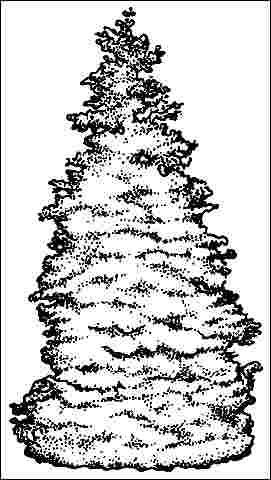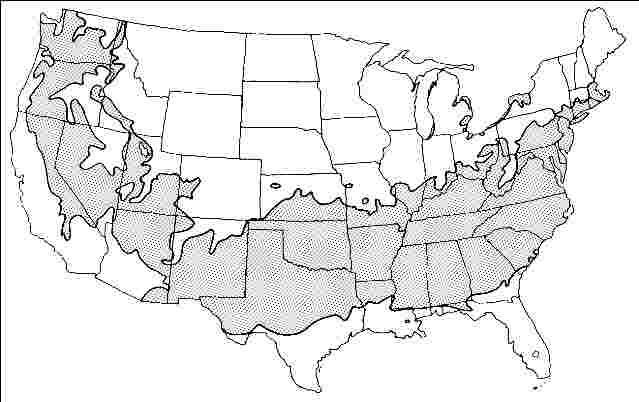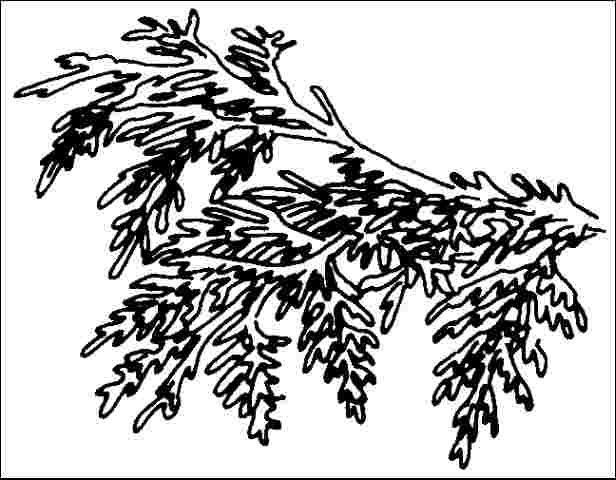Introduction
A native western North American tree, giant cedar can reach 180 to 200 feet in height in some areas of the Northwest but is more often seen at 50 to 70 feet in height with a spread of 30 to 40 feet. Forming a broad pyramidal silhouette with strongly horizontal branches, giant cedar is an evergreen with fragrant, bright golden, delicate needles which generously clothe the branches, casting dense shade beneath the tree. The insignificant yellow flowers are followed by small, half-inch cones which seem a little out-of-place on such a large tree.

Credit: UF/IFAS
General Information
Scientific name: Thuja plicata
Pronunciation: THOO-yuh ply-KAY-tuh
Common name(s): 'Canadian Gold' giant arborvitae, 'Canadian Gold' western redcedar
Family: Cupressaceae
USDA hardiness zones: 6A through 8A (Figure 2)
Origin: native to North America
Invasive potential: not assessed/incomplete assessment
Uses: hedge; screen; specimen; highway median

Credit: UF/IFAS
Description
Height: 50 to 70 feet
Spread: 30 to 40 feet
Crown uniformity: symmetrical
Crown shape: pyramidal, columnar
Crown density: dense
Growth rate: moderate
Texture: fine
Foliage
Leaf arrangement: unknown (Figure 3)
Leaf type: simple
Leaf margin: entire
Leaf shape: scale-like, ovate
Leaf venation: none, or difficult to see
Leaf type and persistence: evergreen, fragrant
Leaf blade length: less than 2 inches
Leaf color: yellow
Fall color: no color change
Fall characteristic: not showy

Credit: UF/IFAS
Flower
Flower color: yellow
Flower characteristics: not showy
Fruit
Fruit shape: cone, elongated
Fruit length: 0.5 to 1 inch
Fruit covering: dry or hard
Fruit color: brown
Fruit characteristics: does not attract wildlife; not showy; fruit/leaves not a litter problem
Trunk and Branches
Trunk/bark/branches: branches don't droop; very showy; typically one trunk; thorns
Pruning requirement: little required
Breakage: resistant
Current year twig color: green, brown
Current year twig thickness: thin
Wood specific gravity: 0.32
Culture
Light requirement: full sun, partial sun, or partial shade, shade tolerant
Soil tolerances: clay; sand; loam; acidic; alkaline; well-drained; occasionally wet
Drought tolerance: moderate
Aerosol salt tolerance: moderate
Other
Roots: not a problem
Winter interest: no
Outstanding tree: yes
Ozone sensitivity: unknown
Verticillium wilt susceptibility: resistant
Pest resistance: resistant to pests/diseases
Use and Management
Tolerating shearing quite well, giant cedar is ideal for use as a hedge or screen, or a specimen for a large landscape. The wood of this tree is commercially used in North America for the manufacture of roof shingles and siding and the split trunks were often used by Native Americans for making totem poles or canoes. Due to its narrow crown, it works well close to buildings where soil is frequently alkaline, and drainage is poor.
Giant cedar naturally occurs on riverbanks, swamps, and even bogs so should be grown in full sun or partial shade on moist, well-drained, fertile soil, and prefers a moist atmosphere. Apparently pH adaptable, growth is stunted on dry soils. Provide irrigation during the summer or locate in an area with moist soil and growth should be rapid.
A few of the other cultivars include: 'Atrovirens', excellent shining green foliage; and 'Fastigiata' ('Hogan'), dense columnar silhouette, very resistant to bagworms—they do not appear to infest this cultivar as much as the species.
Propagation is by seed or cuttings.
Pests and Diseases
No pests or diseases are of major concern but may be occasionally bothered by bagworm.